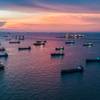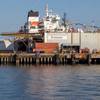“We continue to be successful in world markets and have also found new customers in attractive niches in 2011. At the same time, our regular customers are now again ordering not only in the newbuilding segment but precisely also in the retrofit area,” said Dr. Alexander Nürnberg, Chairman of VDMA Marine and Offshore Equipment Industries, at a late 2011 press conference held in Hamburg. The German maritime economy is an essential industrial sector, which — particularly in the rather economically underdeveloped regions of the northern coastal areas — account for a high percentage of the regional content. Here, the maritime economy has an unchanged supporting part. Additionally, by integration of component suppliers from the southern federal states, a substantial employment is assured. In total there are about 400,000 people active in the German maritime economy, including approximately 19,000 working in shipyards and an additional 72,000 in the ship and offshore suppliers industry. Approximately 22,000 people or so are active in one of the 400 shipping companies, e.g. shipping lines and ship brokers on shore. In addition the ship crews on German ships must be counted – about 10,000 Germans.
Sales of 11.1B Euro in 2010
German marine and offshore suppliers generated sales of 11.1 billion Euro with 72,000 employees in 2010. The export rate was 72 percent. Capacity utilization in production among marine equipment suppliers continued to improve. Short-time work is a thing of the past in most companies.
The offshore supply business in the oil and gas market was not affected by the slump in sales and continued on the growth track as in recent years. Here the business development during the first half-year 2011, resulted in order incomes of 13 ships amounting to 1.8 billion EUR. Herewith, the orders on hand increased again to 1.6 billion gt, valued by 8.2 billion EUR (end of December 2010: 1.4 billion gt; 7.4 billion EUR). The structure of orders on hand back up impressively that the German ship yards have successful performed their orientation towards special shipbuilding.
More Incoming Orders
Incoming orders recovered by eight percent in 2010 following the dramatic slump in shipbuilding orders from October 2008 and the drop of 29 percent at suppliers in 2009. The trend thus seems to have been reversed and slight sales growth can be expected for 2011. The sector has coped by itself with the shipbuilding crisis and expects to achieve continuous, modest growth in the next few years. Especially in the special shipbuilding sector – from oceangoing cruisers to megayachts, from freight ferries to offshore-special ships and naval-shipbuilding – German shipyards proved oneself, in spite of crisis, as being competitive and able to win new orders.
Opportunities in New Export Markets
Marine equipment and offshore suppliers have concentrated on developing new export markets in addition to benefiting from the slowly increasing orders in established areas. The VDMA delegation trips in 2009 and 2010 were successful and are being continued at the same high level in 2011. Emerging shipbuilding giants such as India, Brazil and Russia are coming to the fore in the wake of the top trio of Asian shipbuilding countries China, Korea and Japan. In 2010, 2,780 oceangoing vessels were again ordered worldwide (compared to the previous year: 1,599), with 928 (605) in China, 464 (140) in South Korea, 385 (281) in Japan and 173 (89) in the EU-27, including 21 (7) in Germany. Orders on hand for ships worldwide declined again last year, from 9,226 vessels to 7,822.
China’s still The largest
The main foreign markets for German suppliers in 2010 were in Asia (35 percent) and other European countries (33 percent). China is the largest foreign market, accounting for 21 percent of exports, trailed by Korea (9 percent). The sector is continuing to monitor very closely Asian countries’ efforts to expand local suppliers. German firms are thus aiming to retain their existing edge in the technical and logistics area and improve on this with innovations. Know-how protection is continuing to become more significant, also within joint ventures with local partners in Asia.
Outlook for Offshore
German suppliers are continuing to step up their involvement in the offshore oil and gas industry that they have been displaying for several years. Christoph Daum at MENCK GmbH (Kaltenkirchen): “Demand for high-quality, reliable equipment is high. Availability, dependability and high environmental and safety standards are crucial competitive advantages of German companies in this respect. A system leadership, as frequently called for in the political area, is not a prerequisite for long-term success in this very international business.”
Offshore suppliers are active in the oil and gas area as well as the offshore wind segment. Here there are synergies that favor “learning from one another” and therefore add to the attraction of Germany as industrial location. The VDMA is thus also actively promoting networking among its members between these two maritime segments.
Energy Efficiency is German Core Know-how
A further focus of German suppliers is energy and cost saving and at the same time the environment-friendly operation of ships and offshore plants. In this respect, the German high tech industry has a reputation to defend with its technological edge. “The developments with drive trains and in particular engines are excellent examples here,” said Klaus Deleroi, MAN Diesel & Turbo SE (Augsburg), “as only technology leaders with system expertise are able to optimize the various emission values during the entire lifecycle of an engine. In this process, we certainly have to take into consideration the flexible deployment scenarios. By doing so, we help the customer meeting statutory requirements worldwide and give him a crucial advantage in terms of cost-efficiency and environmental protection.”
An interesting business area is also developing here for the retrofitting of older ships to ensure an immediate improvement in their efficiency and environmental compatibility.
Flexibility
As it has been forecasted exactly a year ago, the workforce with 72,000 employees could be largely retained. There are currently shortages of qualified employees again, as other industrial areas are also booming and the demographic development in Germany is beginning to make its presence felt.
“Thanks to our well above-average training rate and the support of the dual study courses, we are confident about the future,” said Dr. Alexander Nürnberg. He added: “We ask a great deal from our employees. Our reliable personnel policy, our optimism and our top teams in the often owner-managed companies will give us the suitable young talent to master the challenges in the global market with its ever shorter cycles.” Precisely for the small or medium-sized marine equipment and offshore suppliers, the flexible, breathing company is the prerequisite for survival on the world stage.
Shaping the Future
Meyer Werft Management, works council and union IG Metall undersigned a new future oriented labor agreement. “In Europe the last existing ship yards struggle about their business,” says Bernhard Meyer. All the more proves the document in an impressive manner the course for future markets of Meyer Werft. The shipyard with it’s daughter companies, the works council and the union IG Metall jointly agreed in productivity improvement for the next years. As a tribute to their fellow employees for their engagement to optimize the new production processes a bonus as well an employment guarantee till June 2016 has been given.
”With this contract we are saving the new path of constant improvement and productivity increase. We achieved a lot, but still we are not at the end of the way,” said Meyer. “The company will invest this year again 50m EUR into yard facilities, IT-infrastructure and also into staff’s professional skills. The conclusion of the contract is an outstanding example how a company with a labor agreement in long-run saves the particular location and also the jobs,” said IG Metall manager Meinhard Geiken.
Towards Cooperation
To overcome the size limitations of the Flensburg premises and in order to combine experience and references in the offshore business, FSG (Flensburger Schiffbaugesellschaft mbH) entered into a partnership with the Nobiskrug shipyard in Rendsburg. This partnership also encompasses the production facilities at the former HDW-Gaarden shipyard in Kiel, thus offshore units from 60 to 400 m can be offered. The brand name for this new venture, German Offshore, reflects the objective of these two cooperating companies: to introduce renowned German shipbuilding expertise to the broad field of offshore applications. Thanks to its excellent engineering capabilities and extensive production facilities, this cooperation can offer the full product portfolio for offshore sectors. Indeed, such is its expertise and its production capacity, that there are hardly any limits on the size and shape of the products it can develop. The German Offshore product range includes e.g. design and assembly of transform and jack-up platforms, special ships (e.g. heavy lift freighter, OSV Offshore Service Vessels, accommodation ships) as well as cable-laying ships.
(As published in the February 2012 edition of Maritime Reporter & Enginering News -
www.marinelink.com)














